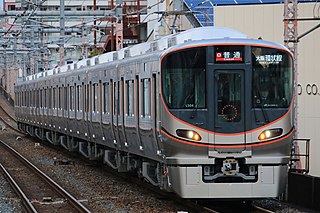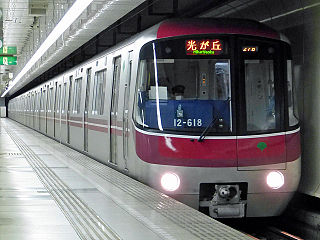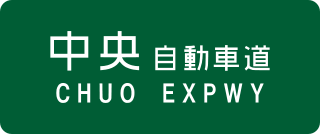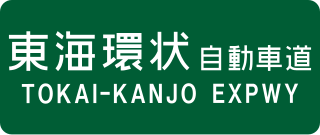




The Central Circular Route(中央環状線Chūō Kanjō-sen), signed as Route C2, is one of the routes of the Shuto Expressway system serving the central part of the Greater Tokyo Area. The route is a circumferential highway running through the outer wards of Tokyo. The route is the middle of three ring expressways planned for the city; the other two being the C1 Inner Circular Route and the C3 Tokyo Gaikan Expressway.
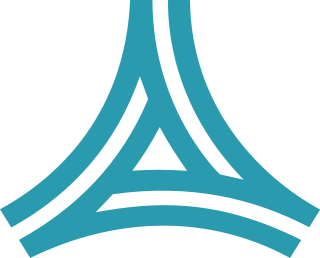
Shuto Expressway is a network of toll expressways in the Greater Tokyo Area of Japan. It is operated and maintained by the Metropolitan Expressway Co., Ltd..

The Greater Tokyo Area is the most populous metropolitan area in the world, consisting of the Kantō region of Japan, including Tokyo Metropolis, as well as the prefecture of Yamanashi of the neighboring Chūbu region. In Japanese, it is referred to by various terms, one of the most common being Capital Region.
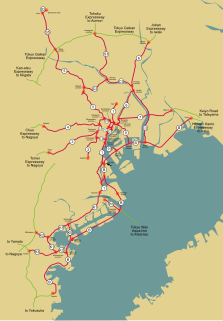
The Tokyo Gaikan Expressway is a national expressway in Japan. It is owned and operated by East Nippon Expressway Company.
The complete route is 48.8 km in length. Construction work on underground sections of the route began in 1992 with the final section opened to traffic on 7 March, 2015. Given the extensive tunneling and engineering challenges involved construction costs for the route were estimated to be 2 Trillion yen. [1]
The route is approximately 8km from the center of the city and goes through the wards of Edogawa, Katsushika, Adachi, Kita, Itabashi, Toshima, Shinjuku, Nakano, Shibuya, Meguro, and Shinagawa.
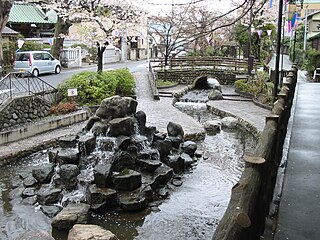
Edogawa is a special ward located in Tokyo Metropolis, Japan. It takes its name from the Edo River that runs from north to south along the eastern edge of the ward. In English, it uses the name Edogawa City.

Adachi is a special ward located in Tokyo Metropolis, Japan. It is located north of the heart of Tokyo. The ward consists of two separate areas: a small strip of land between the Sumida River and Arakawa River and a larger area north of the Arakawa River. The ward is bordered by the cities of Kawaguchi, Sōka and Yashio in Saitama and Katsushika, Sumida, Arakawa, and Kita in Tokyo. The ward is called Adachi City in English.

Kita is a special ward located in Tokyo Metropolis, Japan. The English translation of its Japanese self-designation is City of Kita. The ward was founded on March 15, 1947.

The Yamate Tunnel forms a key part of the Central Circular Route. A deep underground tunnel constructed beneath Yamate Dori, the first section over 11km in length, was opened to traffic on December 22, 2007. From 2010 the tunnel extended the Central Circular Route south from near Ikebukuro to Ohashi Junction connecting with Route 3. The last 9.4 km through Meguro and Shinagawa was opened to traffic on March 7, 2015. [2] When this last section of the tunnel opened the Yamate Tunnel formed Japan's longest, and the world's second longest road tunnel. [3] During the tunnel's first week of operations, traffic volume on the Inner Circular Route was reduced by seven percent from the previous week, and congestion on expressways inside the Central Circular Route (an index measured by recording segments where average traffic speed is less than 40 km/h, and multiplying the affected distance by the affected time) was approximately halved from the previous week. [4]

The Yamate Tunnel carries the Central Circular Route (C2) of the Shuto Expressway in Tokyo, Japan from the Takamatsu on-ramp in Toshima to near the Ōi Junction in Shinagawa. The overall length is 18.2 km.

Ikebukuro is a commercial and entertainment district in Toshima, Tokyo, Japan. Toshima ward offices, Ikebukuro station, and several shops, restaurants, and enormous department stores are located within city limits.

Route 3 is one of the radial routes of the Shuto Expressway system in the Tokyo area. Route 3 runs southwest from Tanimachi Junction in Minato-ku and runs for 12 kilometres through Shibuya-ku, Meguro-ku, and Setagaya-ku. The Route 3 designation ends at the Yoga Rampway and the expressway continues as the intercity Tomei Expressway to Nagoya.
The C2 begins and ends at the Bayshore Route, which serves to close the loop.
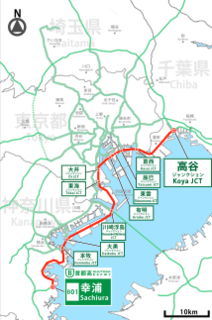
The Bayshore Route of Shuto Expressway is a stretch of toll highway in Greater Tokyo, 70 km, that runs from Yokohama city, Kanazawa ward, to Ichikawa city of Chiba Prefecture. It is an important route that runs between artificial islands of Tokyo Bay by way of bridges and sub-sea tunnels, bypassing Tokyo entirely.
